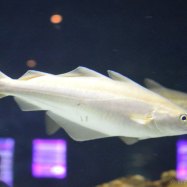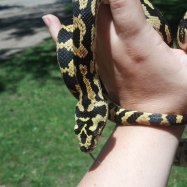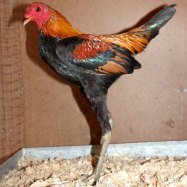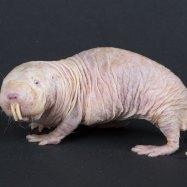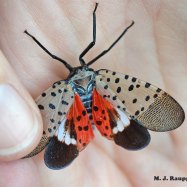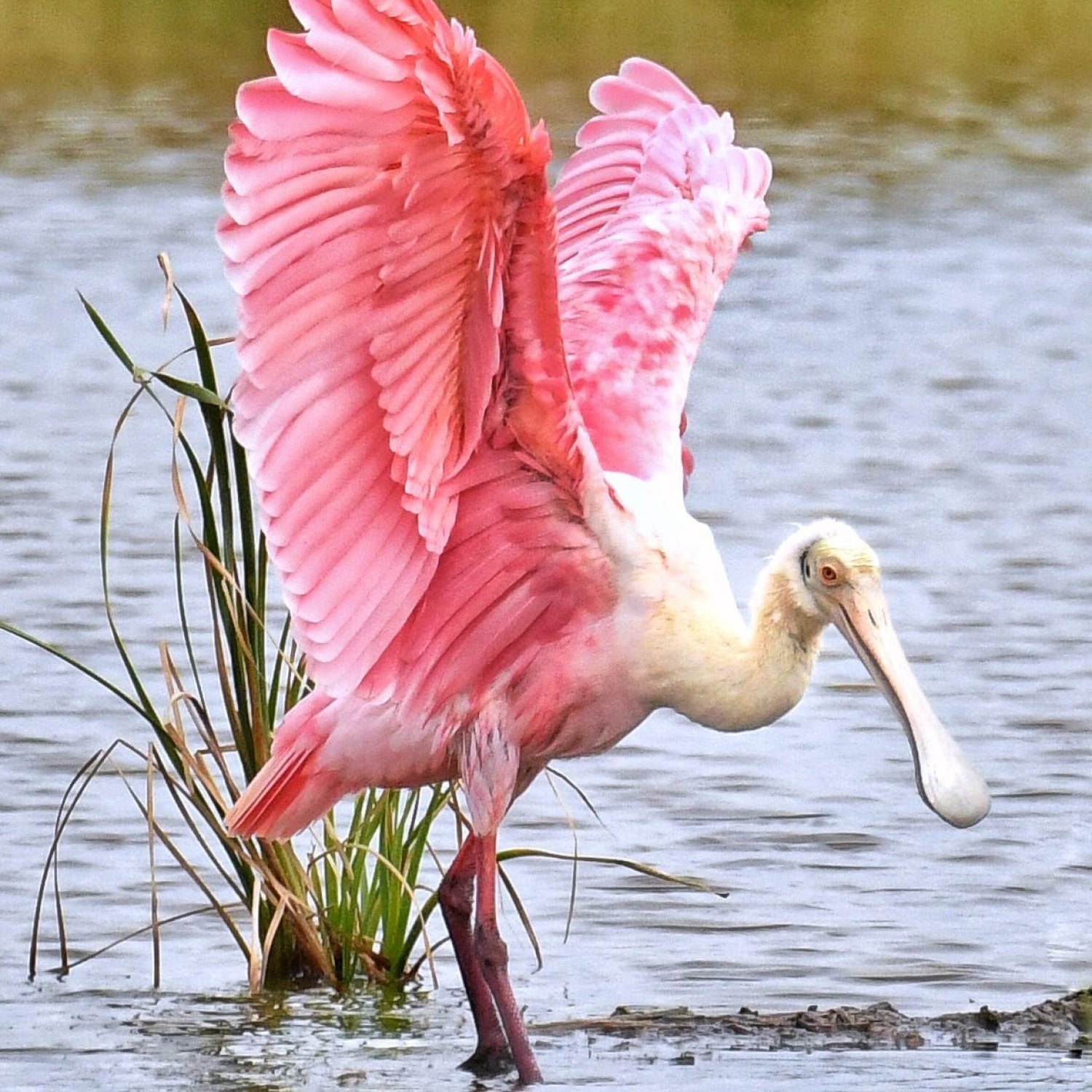
Roseate Spoonbill
27-34 inches (68-86 cm)
Meet the beautiful Roseate Spoonbill, a tall, long-legged wading bird found in the Southern United States, parts of Central America, and the Caribbean. With a length of 27-34 inches, this member of the Threskiornithidae family is often spotted in coastal marshes, feeding on small fish, insects, and crustaceans with its distinctive spoon-shaped bill. Keep an eye out for this elegant bird on your next visit to these regions!
Animal Details Summary:
Common Name: Roseate Spoonbill
Kingdom: Animalia
Habitat: Wetlands, marshes, swamps, mangroves
The Enigmatic Roseate Spoonbill: A Pop of Pink in the Wetlands
Flamingos may rule the realm of pink birds, but there's another feathered creature that gives it a tough competition – the Roseate Spoonbill. With its gorgeous, rosy plumage and distinctive spoon-shaped bill, this elegant bird is a visual treat for bird enthusiasts and nature lovers alike.Native to the Americas, the Roseate Spoonbill (Platalea ajaja) belongs to the Pelecaniformes order and is a member of the Threskiornithidae family. Its scientific name ajaja comes from the Arawak language, meaning "white ibis Roseate Spoonbill." But don't let the name fool you – this stunning bird stands out with its unique physical appearance and fascinating feeding behaviors.
Origins and Distribution
The Roseate Spoonbill is endemic to the wetlands of the Americas, with its widespread habitat ranging from the southern United States to parts of Central America and the Caribbean. Its breeding colonies can be found in coastal regions and interior wetlands, including marshes, swamps, and mangroves. In the United States, this bird is primarily seen in Florida, Texas, and Louisiana.But sadly, the Roseate Spoonbill once faced significant declines due to habitat loss and hunting for its feathers. In the 1800s, these birds were hunted for their beautiful feathers, highly sought after for fashion. Fortunately, with conservation efforts, their numbers have rebounded, and they are now listed as a species of least concern on the IUCN Red List.
The Tall, Long-legged Wonder
The most striking feature of the Roseate Spoonbill is its vibrant color. Its pink feathers come from the pigments in the crustaceans, mollusks, and small fish it consumes Rhode Island Red Chicken. But did you know that this brilliance is not present at birth? As chicks, Roseate Spoonbills have a white and gray plumage, but as they mature, their feathers gradually turn pink. This process can take up to two years.Apart from its pink color, the Roseate Spoonbill stands out for its distinctive spoon-shaped bill. Its long, flattened bill helps in detecting and capturing prey by sweeping it back and forth in the shallow water. Interestingly, its bill is not always spoon-shaped. During the breeding season, the lower bill turns into a vibrant red color, making these birds even more visually appealing.
With a height of 27 to 34 inches and a wingspan of 47 to 52 inches, these birds are quite tall and have an impressive wingspan. Their long legs are another standout feature, allowing them to wade in the water without getting their feathers wet.
A Unique Filter Feeder
The Roseate Spoonbill has a unique feeding method known as filter feeding. They use their bill to sweep through shallow water, feeling for any movement of small fish, crustaceans, and insects. Once they detect prey, they close their bills and flick their heads upwards, allowing the water to drain out, leaving the food trapped in their specialized bill.This feeding behavior makes them an essential part of their ecosystem. They prevent overpopulation of small fish and control the spread of aquatic invertebrates. As a result, their presence helps maintain the balance of the wetland ecosystem.
An Ever-changing Coloration
While the Roseate Spoonbill is known for its iconic pink color, it is not always seen in this hue. During the breeding season, their pink feathers often turn bright scarlet, thanks to their diet of crustaceans.But this color change is not just limited to their feathers. Their eyes and legs also change color with their feathers, from yellow to dark red. It's almost as if they are wearing a constant costume party!
An Unconventional Colony
Another interesting fact about the Roseate Spoonbill is its unique breeding behavior. Unlike most birds that nest in treetops, these birds prefer to nest on the ground or in low shrubs. They build their nests by forming flat platforms out of mud, sticks, and plant matter.But what's truly fascinating is their choice of partners. Unlike many bird species, Roseate Spoonbills do not have a specific mate. They engage in a mixed mating system, where males have multiple partners, and females choose their mates based on their nest building abilities.
The Importance of Wetland Conservation
The Roseate Spoonbill is an essential part of the wetland ecosystem, and its conservation goes hand in hand with preserving these vast, diverse habitats. Unfortunately, wetlands are one of the most threatened ecosystems globally, with over 50% of wetlands disappearing in the past century.These birds are also highly susceptible to human disturbances, which can cause them to abandon their nests and chicks. Habitat loss due to human development, pollution, and natural disasters are some of the most significant threats they face. Therefore, it is crucial to educate and spread awareness about the importance of protecting and preserving the wetlands and the creatures that call it home.
A Symbol of Conservation Success
The decline in the Roseate Spoonbill population in the 1800s prompted conservation efforts that have played a significant role in their recovery. Today, these birds are a symbol of conservation success, with their numbers on the rise. It is a testament to the positive impact that conservation efforts can have on a species' survival.However, there is still much work to be done. As human activities continue to impact the environment, it is vital to continue conservation efforts to ensure the survival of the Roseate Spoonbill and other wildlife.
A Feathered Beauty to Witness
If you want to catch a glimpse of these stunning birds in their natural habitat, head to the wetlands of the Americas during the breeding season (April to July). Don't forget to bring your binoculars and camera for close-up views and capturing the perfect photo.But remember to maintain a safe distance and avoid disturbing the birds. Observing them from afar is the best way to ensure their safety and to appreciate their unique beauty and behaviors.
In conclusion, the Roseate Spoonbill is a remarkable bird that stands out with its striking pink color and distinctive features. Its resilience and conservation success story make it a species worth protecting and admiring. The next time you come across a Roseate Spoonbill, take a moment to appreciate its beauty and the crucial role it plays in maintaining the balance of the wetlands.

Roseate Spoonbill
Animal Details Roseate Spoonbill - Scientific Name: Platalea ajaja
- Category: Animals R
- Scientific Name: Platalea ajaja
- Common Name: Roseate Spoonbill
- Kingdom: Animalia
- Phylum: Chordata
- Class: Aves
- Order: Pelecaniformes
- Family: Threskiornithidae
- Habitat: Wetlands, marshes, swamps, mangroves
- Feeding Method: Filter feeding
- Geographical Distribution: Americas
- Country of Origin: United States
- Location: Southern United States, parts of Central America and the Caribbean
- Animal Coloration: Pink with white and red
- Body Shape: Tall, long-legged wading bird
- Length: 27-34 inches (68-86 cm)
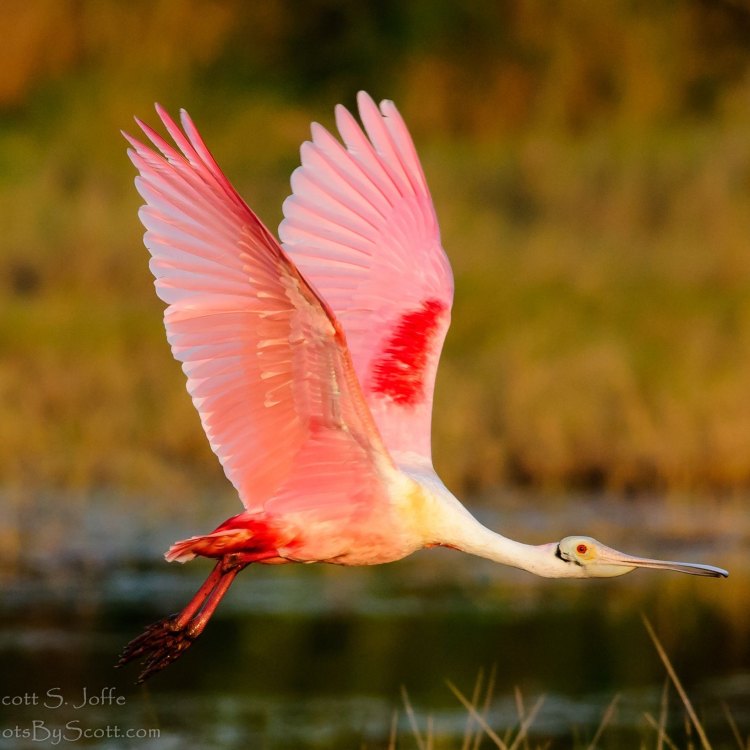
Roseate Spoonbill
- Adult Size: Large
- Average Lifespan: Up to 15 years
- Reproduction: Sexual
- Reproductive Behavior: Courtship displays and pair bonding
- Sound or Call: Rounded grunting
- Migration Pattern: Some populations are migratory
- Social Groups: Colonial nesting behavior
- Behavior: Sociable, however, they can be aggressive when defending their nests
- Threats: Habitat loss, pollution, hunting
- Conservation Status: Least Concern
- Impact on Ecosystem: Important role in wetland ecosystems as a predator of small aquatic animals
- Human Use: Bird watching, ecotourism
- Distinctive Features: Long, spoon-shaped bill; rosy-pink plumage; black facial mask
- Interesting Facts: Roseate Spoonbills are closely related to ibises; their pink coloration is due to their diet of crustaceans and small aquatic animals
- Predator: Alligators, large birds of prey, raccoons
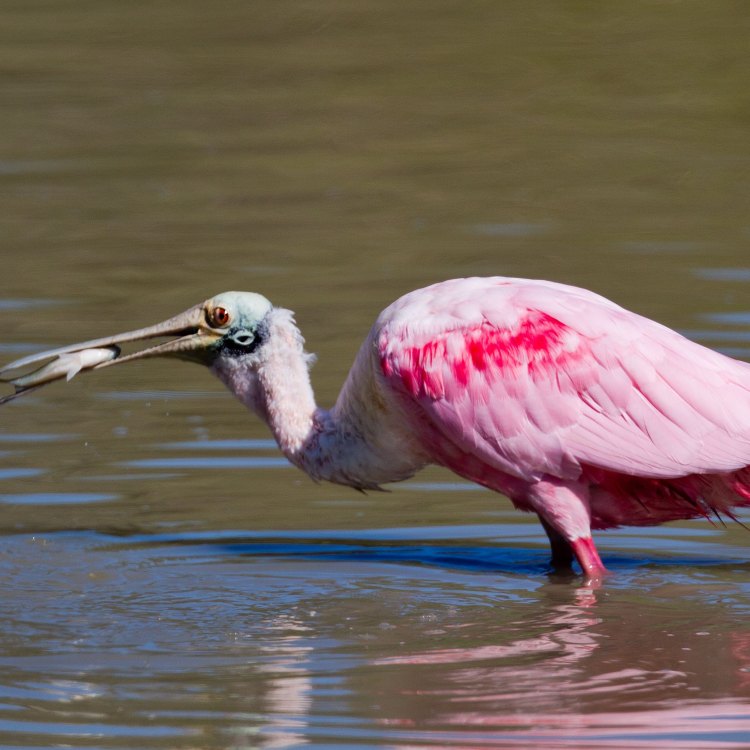
Platalea ajaja
The Unique and Colorful World of the Roseate Spoonbills
The world is full of stunning and unique creatures that never cease to amaze us. From the vibrant colors of tropical birds to the mysterious depths of the ocean, our planet is home to a vast array of fascinating species. Among these, the Roseate Spoonbill stands out for its distinct appearance and interesting behaviors.Known for its beautiful rosy-pink plumage and long spoon-shaped bill, the Roseate Spoonbill is a large bird that inhabits wetlands and coastal regions in North and South America PeaceOfAnimals.Com. But what makes this bird truly remarkable are its distinctive features, fascinating behaviors, and important role in the ecosystem. In this article, we will delve deeper into the world of the Roseate Spoonbill and discover what makes it so unique and captivating.
The Size and Lifespan of the Roseate Spoonbill
The Roseate Spoonbill is a relatively large bird, reaching up to 32 inches in height and weighing around 3-4 pounds. This makes it one of the largest wading birds in North and South America. Due to its large size, it is often mistaken for a flamingo, but the two are not closely related.On average, the Roseate Spoonbill has a lifespan of 10-15 years, though some individuals have been recorded living up to 20 years in captivity. In the wild, survival rates are lower due to various threats such as habitat loss and predators, which we will discuss in more detail later on.
The Reproduction and Courtship Behavior of the Roseate Spoonbill
Like most birds, the Roseate Spoonbill reproduces sexually. During the breeding season, which typically occurs from March to May, the birds engage in elaborate courtship displays to attract a mate Robber Flies. These displays involve various behavioral movements, such as stretching their wings, bobbing their heads, and spreading their tail feathers to reveal their vibrant pink under-feathers.Once a pair is formed, they will build their nest together in a colony with other spoonbills, often on the ground or in low trees or shrubs. They will then lay 2-4 eggs, which both parents take turns incubating for about 23-24 days. After the eggs hatch, both parents also take on the responsibility of feeding and caring for the chicks until they are ready to fledge and leave the nest, usually after 6-7 weeks.
The Unique Vocalizations and Migration Patterns of the Roseate Spoonbill
Birds are known for their various calls and songs, and the Roseate Spoonbill is no exception. However, its call is quite distinctive compared to other birds. Described as a "rounded grunting," the sound of the Roseate Spoonbill is a low, nasal note that is often compared to a pig's grunt. This call is used for communication between individuals, especially during courtship or when defending their territory.While some populations of Roseate Spoonbills are resident birds, others are migratory, meaning they travel long distances to find suitable breeding and feeding grounds. In the United States, the birds in Florida and Texas are considered to be resident, while those in other states, such as Louisiana and the Carolinas, are migratory. Migratory spoonbills can travel as far as Central America and the Caribbean during the winter months.
The Social Behaviors and Threats Faced by the Roseate Spoonbill
One of the most fascinating behaviors of the Roseate Spoonbill is its colonial nesting behavior. This means that they nest in large groups, often with other wading birds such as herons and egrets. This behavior provides a sense of safety and protection, as there are more eyes and ears to watch out for predators.However, the Roseate Spoonbill can also display aggressive behaviors when it comes to defending their nests. They are known to fiercely protect their territory from any potential threats, even attacking larger predators such as alligators and large birds of prey like eagles and ospreys.
Unfortunately, the increasing human population and development have caused significant habitat loss for the Roseate Spoonbill. Wetlands and coastal regions, where the birds typically reside, have been drained and destroyed for agriculture, urban development, and other human activities. This, along with pollution and hunting, has led to a decline in the spoonbill population. Fortunately, due to conservation efforts and stricter regulations, their numbers have slightly increased, and they are currently listed as Least Concern on the IUCN Red List.
The Role of the Roseate Spoonbill in the Ecosystem
Despite the ongoing threats to their population, the Roseate Spoonbill plays a crucial role in maintaining the balance of wetland ecosystems. As predators, they feed on small aquatic animals such as fish, crustaceans, and insects, keeping their populations in check. In turn, this helps to maintain the health and diversity of the entire ecosystem.Research has also shown that the presence of spoonbills in wetlands can help to improve water quality. As they feed, their spoon-shaped bills agitate the mud at the bottom of the water, causing buried nutrients to resurface, which helps to fertilize the surrounding plants and promote growth. They are truly an essential part of the wetland ecosystem.
The Relationship Between Humans and the Roseate Spoonbill
Humans have had a long-standing relationship with the Roseate Spoonbill, with both positive and negative impacts on the species. Historically, the bird was highly sought after for its feathers, which were used to decorate hats, fans, and other luxury items in the 19th and early 20th centuries. This, along with other forms of hunting and persecution, caused a significant decline in their population.However, today the Roseate Spoonbill is more valued for its role in ecotourism and bird-watching. People from all over the world travel to see these stunning birds in their natural habitats, which not only brings economic benefits to the local communities but also raises awareness for the conservation of the species. With its colorful appearance and interesting behaviors, the Roseate Spoonbill has become a favorite among bird enthusiasts.
The Distinctive Features and Interesting Facts about the Roseate Spoonbill
It's hard not to be captivated by the unique appearance of the Roseate Spoonbill. As mentioned earlier, their vibrant rosy-pink plumage is what gives them their name. But it's not just their color that makes them stand out. Their long, spoon-shaped bill is also a defining feature that sets them apart from other birds. This bill is used to scoop up their food from the water, similar to the way a spoon is used.Another interesting fact about the Roseate Spoonbill is that it is closely related to the ibises, not flamingos as many people often assume. Both species are in the same family, Threskiornithidae, and can often be found in the same habitats. But unlike the ibis, the beautiful pink coloration of the spoonbill is not due to genetics, but rather their diet. By consuming a large amount of shrimp and other crustaceans, their feathers turn pink, much like how flamingos get their pink color from their diet.
The Predators of the Roseate Spoonbill
Of course, every creature has its predators, and the Roseate Spoonbill is no exception. In their natural habitats, they face threats from alligators, large birds of prey, and even raccoons, which will feed on their eggs and young chicks. However, with their aggressive behavior and large group nesting habits, they are usually successful in defending themselves and their offspring.In recent years, the introduction of non-native species such as pythons and iguanas in their habitats has also become a threat to the spoonbill population. These invasive species can easily prey on the birds and their eggs, further contributing to their declining numbers.
In Conclusion
In conclusion, the Roseate Spoonbill is a truly unique and captivating bird that inhabits the wetlands and coastal regions of North and South America. With its vivid pink plumage, distinct spoon-shaped bill, and interesting behaviors, it has captured the hearts and minds of many. However, like many other species, it faces threats from human activities and habitat loss. It is important for us to continue our efforts in preserving their habitats and protecting these stunning creatures for future generations to admire and appreciate. So next time you spot a Roseate Spoonbill in the wild, take a moment to admire its beauty and remember the important role it plays in our ecosystem.
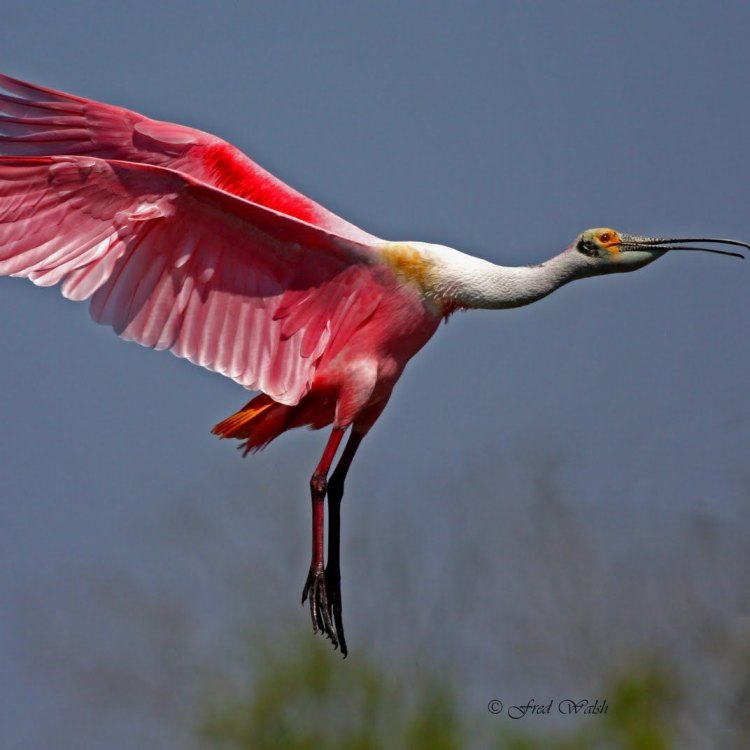
The Enigmatic Roseate Spoonbill: A Pop of Pink in the Wetlands
Disclaimer: The content provided is for informational purposes only. We cannot guarantee the accuracy of the information on this page 100%. All information provided here may change without prior notice.

